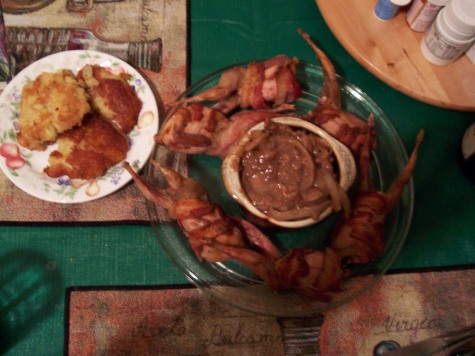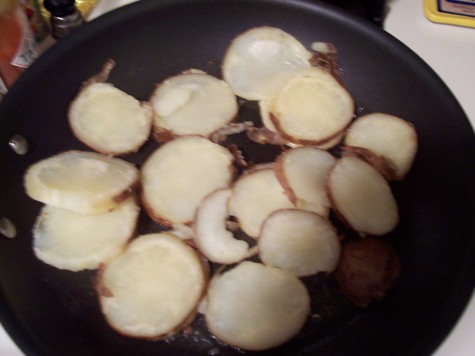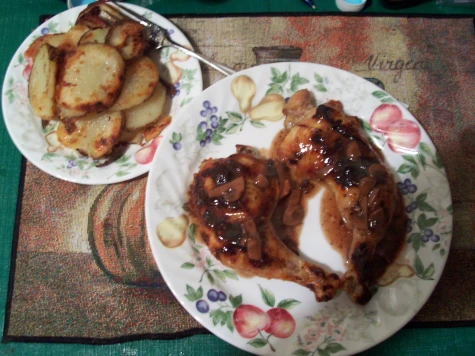My return from Detroit happily coincided with the arrival of my long-awaited verjuice from Deborah Peterson’s Pantry. Verjuice is the sour juice pressed from unripe green grapes; in a time when lemons and their juice were crazy tales brought home by Crusaders returning from Outremer and wine was too expensive to let turn to vinegar, verjuice provided the sour/acid taste to Medieval cooking. It continued to see use in this way right up to the 18th Century, but in the end verjuice was replaced by readily available supplies of lemons and cheap wine vinegar in much the same way that sugar replaced honey as the primary sweetener of the Northern European diet.
It’s tough to find an 18th Century British recipe that actually uses verjuice. By the time Hannah Glasse wrote her book in 1745, Britain was at the center of global trade. I would not, however, be a gamer/librarian/history buff if I didn’t have a few medieval cookbooks lying around, so I dusted them off and invited some friends.
There’s no better way to try verjuice than by using a recipe where it figures in the title. This one originates from an unsigned 14th Century Tuscan manuscript, and is reprinted with its modern version in The Medieval Kitchen: Recipes from France and Italy.
Gratonata of Chickens: Cut up your chickens, fry them with pork fat and with onions; and while they are frying add a little water so that they cook nicely in the pan; and stir them often with a large spoon; add spices, saffron, and verjuice and then boil; and for each chicken take four egg yolks, mix them with verjuice and then boil them separately; and beat everything together in the pan, and boil everything together with the pieces of chicken; and when it boils remove it from the fire and eat it.
Chicken with Verjuice:
- 1 chicken
- 1 medium onion
- 2 oz pork fatback
- 10 tbs water
- 10 tbs verjuice
- 4 egg yolks
- 1/2 tsp ground mace
- 1/2 tsp ground ginger
- 1 pinch cinnamon
- 1 pinch saffron threads
- salt and pepper
Cut chicken into serving pieces, season with salt and pepper, and slice onion thinly. Cut fatback into small dice and render the fat in a heavy bottomed casserole or dutch oven. Add chicken and onion and brown on all sides. Add water and bring to the boil, then add 3 tbs verjuice and the spices. Cover and simmer for about 45 minutes. Remove from heat.
When chicken is done, beat remaining 7 tbs of verjuice into the egg yolks in a small saucepan. Bring nearly to the boil over low heat and then add to the casserole with the chicken. Mix well until sauce is thick.
This recipe reminded me a lot of chicken adobo, but with a slight fruitiness due to the presence of verjuice rather than vinegar. It’s really worth the trouble to get ahold of actual verjuice (you can use it instead of vinegar or lemon juice just about anywhere, and unlike them it doesn’t combine poorly with wine on the palate), but if you really want to try this recipe without it the book suggests using the juice of one lemon combined with 3 tbs water as a substitute.
To go with the chicken, we made some gnocchi. The gnocchi here are the original gangstas of the pasta clan, dating from a time before either semolina or potato flour for starch. This recipe is also from The Medieval Kitchen, and is from another unsigned 14th Century Tuscan manuscript.
If You Want Some Gnocchi, take fresh cheese and mash it, then take some flour and mix with egg yolks as in making migliacci. Put a pot full of water on the fire and, when it begins to boil, put the mixture on a dish and drop it into the pot with a ladle. And when they are cooked, place them on dishes and sprinkle with plenty of grated cheese.
Gnocchi
- 1 and 1/4 lbs cream cheese
- 1 and 1/2 cups flour
- 6 egg yolks
- salt
- freshly grated parmesan cheese
Mash cream cheese into paste. Mix in flour by hand and add salt to taste. Blend in egg yolks, continuing to knead until a smooth mixture forms. Boil water in a large pot, then reduce to simmer. Drop half-teaspoonfuls of mixture into simmering water and wait until they rise to the top on their own. Drain and serve, topped with parmesan cheese.
This recipe didn’t specify the flour type, but you can’t go wrong by doing what I did and using spelt flour. It’s still historically accurate and it gives the gnocchi a slight nutty flavor. This recipe makes a lot of dough, which is not a bad thing because it stores pretty well and the gnocchi themselves are easy to make.
But, you ask me, what’s with two Italian recipes ? Aren’t you all about British food? Fear not, gentle readers. The vegetable recipe I used is 100% English. It’s from The Forme of Cury, compiled in 1390 by Richard II’s master cooks (before all that Tragedy Of unpleasantness). The modern version here is from Lorna J. Sass’s To The King’s Taste. Since H.M.’s kitchen staff wrote in English (albeit Medieval English) the original here has a little more “flavor”:
Funges:Take funges and pare hem clene and dyce hem. Take leke, and shred hym small and do hym to seeth it in gode broth. Color it with safron, and do there-inne powder-fort.
Mushrooms and Leeks
- 8 small leeks
- 1 and 1/2 lbs large mushrooms, quartered
- 3 tbs butter
- 1 cup chicken or vegetable stock
- 1/2 tsp brown sugar (before 1492 this would have come from traders in the Levant)
- 1/8 tsp saffron
- 1/2 tsp minced fresh ginger
- beurre manie (3 tbs flour mixed with 3 tbs soft butter)
- salt and pepper
Wash leeks and discard tops and roots. Slice white part into rings. Saute in 3 tbs butter until soft, then add mushrooms and stir to coat. Combine stock, sugar, and spices and pour over vegetables. Cover and simmer 2 minutes, and then add beurre manie, stirring rapidly until thickened. Salt and pepper to taste.



